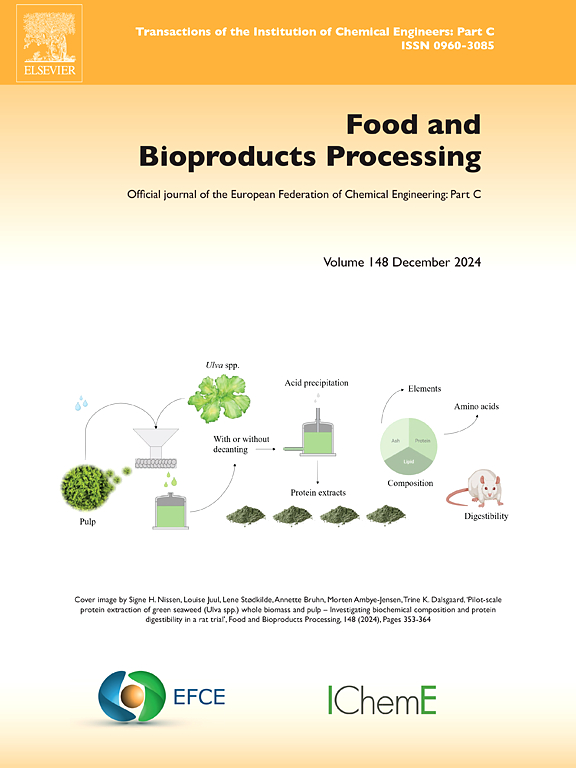Enhanced strawberry preservation using H. pluvialis residue-based films
IF 3.4
2区 农林科学
Q2 BIOTECHNOLOGY & APPLIED MICROBIOLOGY
引用次数: 0
Abstract
Novel films composed of Haematococcus pluvialis residue (HPR), chitosan (CS), citric acid (CA), glycerol (GL), and calcium chloride (CaCl₂) were developed to improve strawberry preservation. The rheological, structural, and functional properties of film-forming aqueous solutions (CS/CA, CS/CA/GL, CS/CA/GL/Ca, CS/CA/GL/Ca/HPR) were analyzed. It revealed HPR-induced shear-thinning behavior (η = 2260 Pa·s) and enhanced rigidity (G'' = 750.51 Pa at 100 rad/s) via hydrogen bonding and Ca²⁺ crosslinking. FTIR and UV–vis spectra confirmed molecular interactions between carboxyl groups of HPR and amino residues of CS. The films with 0.6 % HPR exhibited superior mechanical strength (tensile strength: 12.16 MPa; elongation at break: 135.36 %), reduced water vapor permeability (1.14 × 10−10gm⁻¹s⁻¹Pa⁻¹), and antioxidant activity (73.16 % DPPH scavenging) than CS film. Antibacterial efficacy against S. aureus and E. coli peaked at 0.8 % HPR. The weight loss of strawberry was reduced by using the HPR film (13.08 % vs. control: 29.5 %), retained ascorbic acid (19.98 mg/100 g vs. control: 6.75 mg/100 g). The shelf life of strawberries was extended by 30 days, which is 15 days longer than that of those wrapped with polyethylene film. The polysaccharides, astaxanthin, and algal proteins in HPR improved barrier properties, oxidative stability, and microbial resistance. These results highlight the potential of HPR films as sustainable, multifunctional packaging to extend fruit shelf life.
雨蚜残基膜增强草莓保鲜效果
以雨红球菌渣(HPR)、壳聚糖(CS)、柠檬酸(CA)、甘油(GL)、氯化钙(cacl2)为主要原料制备了草莓保鲜膜。分析了CS/CA、CS/CA/GL、CS/CA/GL/ CA、CS/CA/GL/ CA、CS/CA/GL/ CA/ HPR成膜水溶液的流变学、结构和功能特性。hpr诱导的剪切减薄行为(η = 2260 Pa·s)和通过氢键和Ca 2 +交联增强的刚度(G”= 750.51 Pa,温度为100 rad/s)。FTIR和UV-vis光谱证实了HPR的羧基与CS的氨基残基之间的分子相互作用。HPR含量为0.6 %的薄膜具有优异的机械强度(抗拉强度:12.16 MPa;断裂伸长率:135.36 %),降低了水蒸气渗透性(1.14 × 10−10gm⁻¹s - Pa⁻¹),抗氧化能力(73.16 %清除DPPH)比CS膜。对金黄色葡萄球菌和大肠杆菌的抗菌效果最高,为0.8 % HPR。使用HPR膜后,草莓的失重率为13.08 %(对照29.5 %),抗坏血酸残留量为19.98 mg/100 g(对照6.75 mg/100 g)。草莓的保质期延长了30天,比聚乙烯薄膜包装的草莓延长了15天。HPR中的多糖、虾青素和藻类蛋白改善了屏障性能、氧化稳定性和微生物抗性。这些结果突出了HPR薄膜作为可持续,多功能包装延长水果保质期的潜力。
本文章由计算机程序翻译,如有差异,请以英文原文为准。
求助全文
约1分钟内获得全文
求助全文
来源期刊

Food and Bioproducts Processing
工程技术-工程:化工
CiteScore
9.70
自引率
4.30%
发文量
115
审稿时长
24 days
期刊介绍:
Official Journal of the European Federation of Chemical Engineering:
Part C
FBP aims to be the principal international journal for publication of high quality, original papers in the branches of engineering and science dedicated to the safe processing of biological products. It is the only journal to exploit the synergy between biotechnology, bioprocessing and food engineering.
Papers showing how research results can be used in engineering design, and accounts of experimental or theoretical research work bringing new perspectives to established principles, highlighting unsolved problems or indicating directions for future research, are particularly welcome. Contributions that deal with new developments in equipment or processes and that can be given quantitative expression are encouraged. The journal is especially interested in papers that extend the boundaries of food and bioproducts processing.
The journal has a strong emphasis on the interface between engineering and food or bioproducts. Papers that are not likely to be published are those:
• Primarily concerned with food formulation
• That use experimental design techniques to obtain response surfaces but gain little insight from them
• That are empirical and ignore established mechanistic models, e.g., empirical drying curves
• That are primarily concerned about sensory evaluation and colour
• Concern the extraction, encapsulation and/or antioxidant activity of a specific biological material without providing insight that could be applied to a similar but different material,
• Containing only chemical analyses of biological materials.
 求助内容:
求助内容: 应助结果提醒方式:
应助结果提醒方式:


